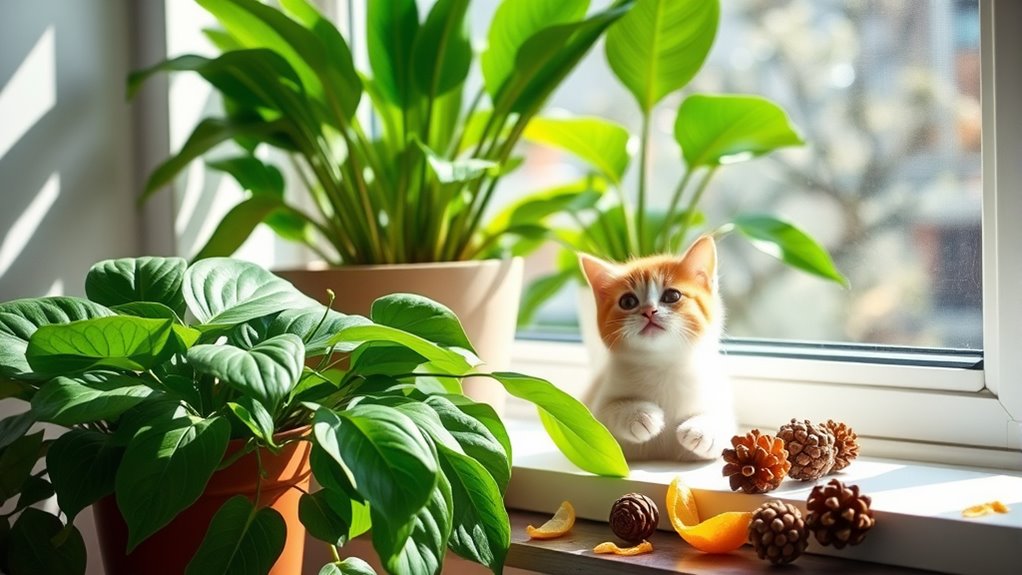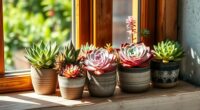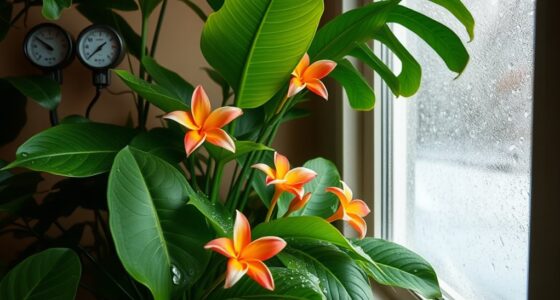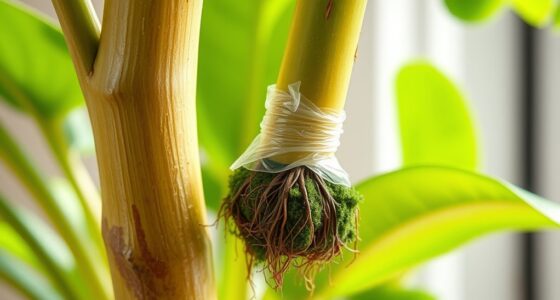To keep your cats out of indoor plants, use citrus-based repellent sprays or vinegar solutions, and incorporate deterrents like aluminum foil or plastic forks in the soil. Place plants on high shelves or in hanging planters, creating a cat-free zone if necessary. Offer cat-friendly alternatives like catnip or grass to channel their curiosity. Consistent training helps discourage unwanted behavior too. There’s plenty more you can do to achieve a harmonious home with plants and pets alike.
Key Takeaways
- Use citrus-based sprays or vinegar solutions to create an unpleasant scent for cats around plants.
- Place plants on high shelves or use hanging planters to keep them out of reach.
- Employ physical barriers like crinkled foil, rocks, or netting to deter cats from digging.
- Offer cat-friendly alternatives like cat grass or catnip to satisfy their curiosity without harming your plants.
- Train your cat with consistent redirection to toys and games, reinforcing their focus away from plants.
Understanding Cat Behavior Towards Plants
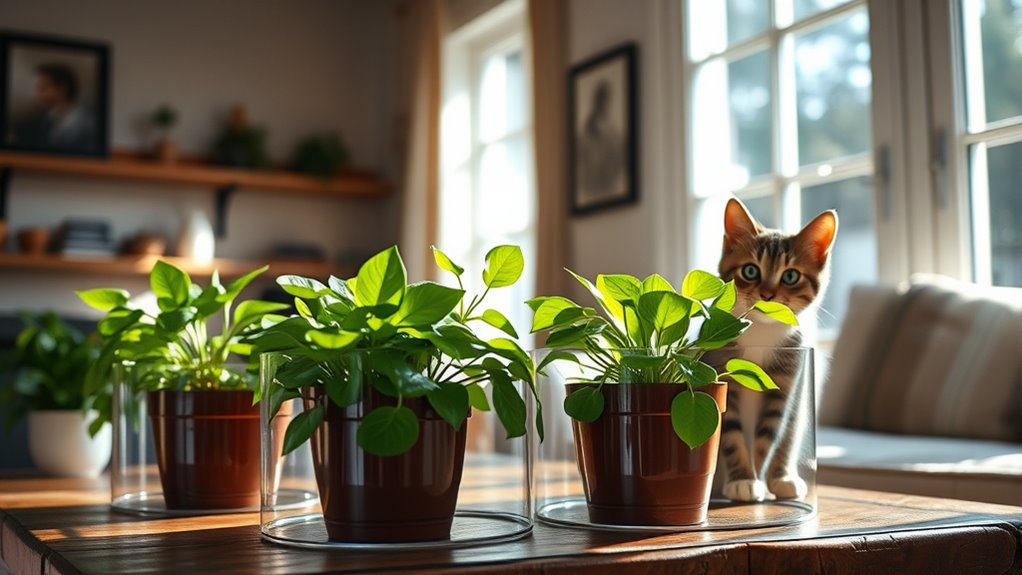
While it might seem puzzling why your cat is so drawn to your indoor plants, understanding their natural instincts can shed light on this behavior.
Cats are inherently curious, often attracted to the textures and movements of leaves. The rustling sounds can mimic prey, triggering their hunting instincts. Additionally, the instinct to consume vegetation may persist from wild ancestry for self-purging. Often, cats may exhibit this behavior due to their increased boredom levels if they lack stimulating toys. Moreover, many cats are naturally drawn to high-fiber foods that can aid in digestion. Emotional detachment can also influence a cat’s behavior, as stress may drive them to nibble on your greenery.
Additionally, cats might seek out plants to fulfill nutritional needs or to help dislodge hairballs. Boredom and stress can also drive them to nibble on your greenery. If they lack stimulating toys, plants become the next best option.
Their playful nature often leads them to treat foliage as playthings. By recognizing these instincts, you can better manage your cat’s interactions with your indoor plants and ensure their well-being.
Effective Repellent Sprays and Oils
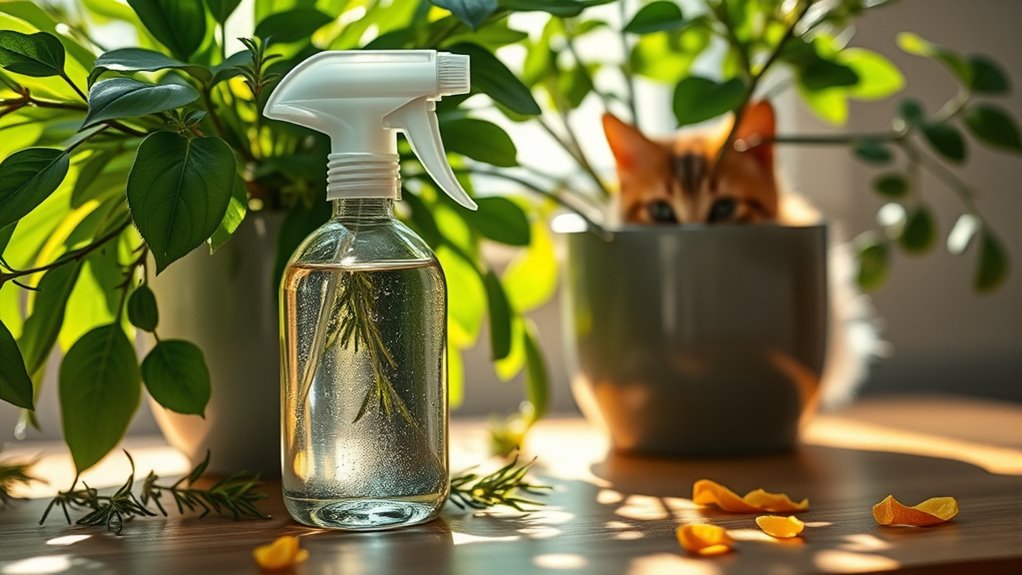
If you’re looking to keep your cat away from indoor plants, effective repellent sprays and oils can be a game changer.
Citrus-based sprays, like diluted lemon or orange juice, deter cats with their strong scent. A simple vinegar solution, made from equal parts water and vinegar, also works well. For a more natural approach, consider essential oils like lavender and eucalyptus, both of which cats typically avoid. Lavender oil is known for its calming effects and can also provide a pleasant aroma while keeping cats at bay. Additionally, many houseplants, such as non-toxic XL houseplants, can be safely added to your home without attracting your cat’s curiosity. You can even create homemade sprays by mixing water with essential oils or cayenne pepper. Incorporating hydrating techniques into your routine can also help maintain a comfortable environment for both you and your cat. If you prefer commercial options, look for products like Pet MasterMind or Colton’s Naturals, which use safe, natural ingredients. Just remember to test any spray on your plants first and monitor your cat’s reactions. Additionally, using least-invasive deterrents can help ensure your cat remains comfortable while being kept away from your plants.
Utilizing Physical Barriers
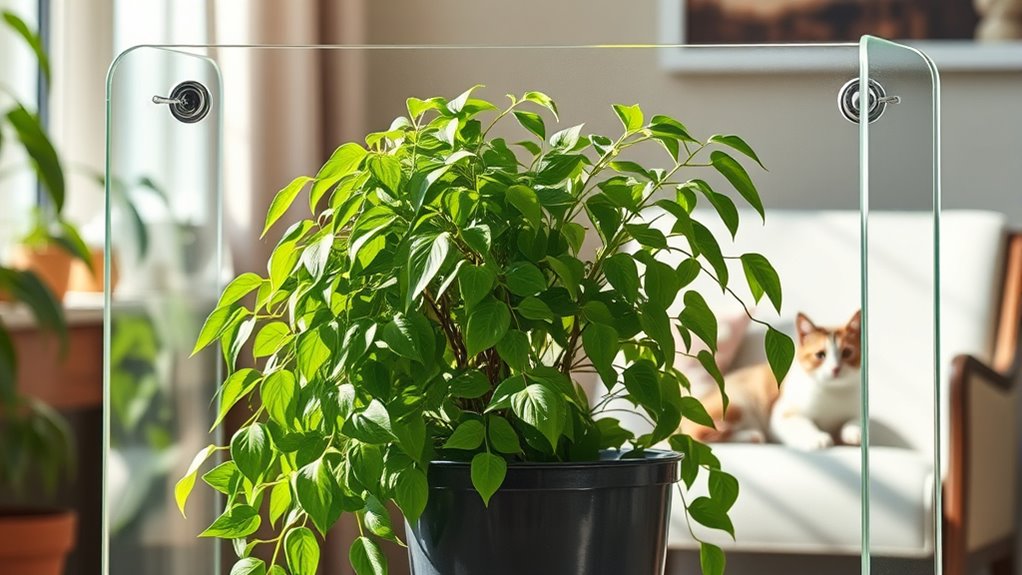
Effective repellent sprays and oils can help keep your cat away from indoor plants, but physical barriers offer a more hands-on approach.
Start by covering the soil with aluminum foil, rocks, or pinecones to make it uncomfortable for your cat to dig. You can also stick plastic forks into the soil, tines up, to create a physical deterrent. Additionally, choosing pet-safe plants can reduce the chances of your cat being attracted to your plants. Understanding proper diet for your cat can also help in minimizing their urge to explore plants. Regular grooming can also help reduce shedding and minimize hair transfer to your plants and home environment. Furthermore, using lightweight netting can also help protect your plants from curious paws while providing adequate light for their growth.
For plant protection, consider using lightweight netting, metal cages, or glass cloches to keep your plants safe while allowing light and humidity in. Additionally, wrapping pots in crinkled foil can deter cats with its unpleasant texture.
Strategic Plant Placement
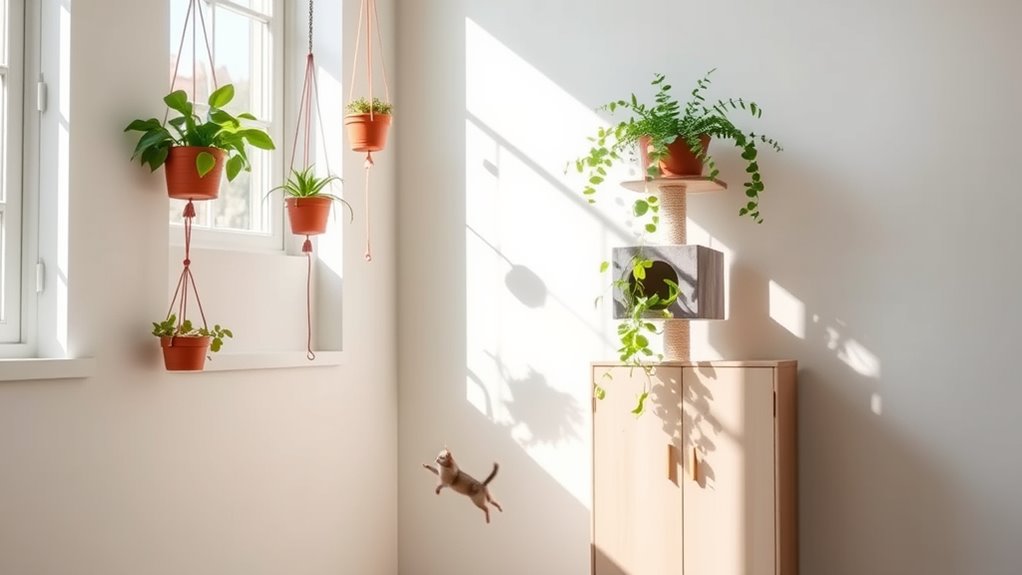
To keep your indoor plants safe from curious cats, strategic placement is key.
Start by placing your plants on high shelves where cats can’t easily reach them. Hanging planters are another great option, keeping your greenery out of paws’ reach while enhancing your space’s aesthetics. Non-toxic plants like catnip and catmint can also be used in areas where cats are allowed, providing them with safe options to explore. Additionally, consider incorporating freshly squeezed juices as a natural deterrent for cats, as some citrus scents can be off-putting to them. It’s also beneficial to understand the importance of safe plants for both your cats and your greenery to ensure a harmonious home environment. Using strategic plant placement can enhance the overall aesthetics of your home while minimizing cat interference.
Elevate your plants on high shelves or use hanging planters to keep them safe from curious cats while adding style to your space.
If possible, designate a separate room for your plants, creating a cat-free zone. You can also place plants in inaccessible areas, like corners or behind furniture, to reduce cat interference.
Consider adding decorative obstacles around your plants; these can discourage your feline friends from getting too close.
Offering Cat-Friendly Alternatives
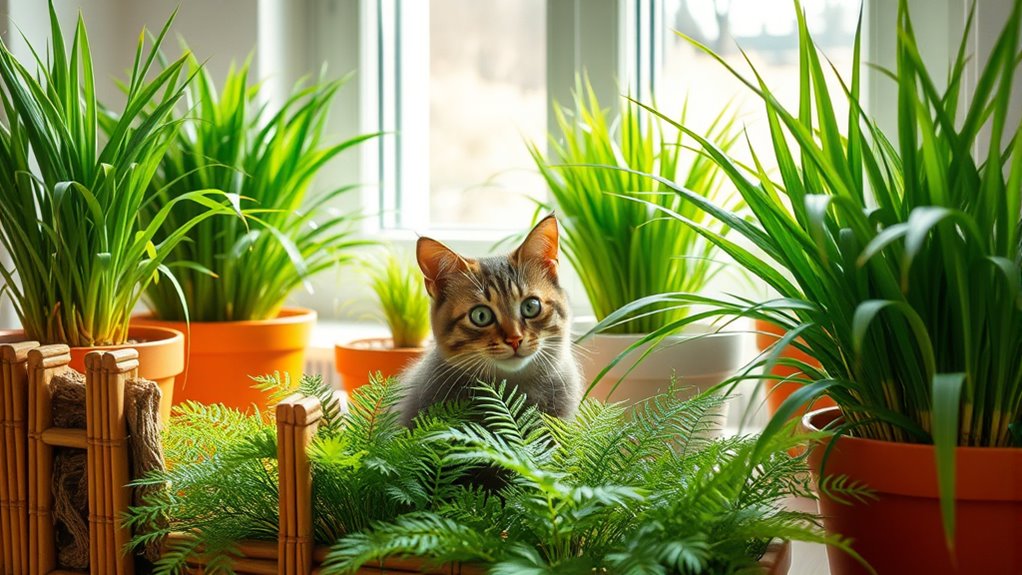
While keeping your indoor plants safe from your curious feline, it’s essential to offer cat-friendly alternatives that satisfy their natural instincts.
Consider planting catnip, which is non-toxic and stimulates playfulness. Cat grass promotes digestive health and helps prevent hairballs, while valerian can have calming effects. Incorporating cat-friendly plants into your home not only enhances aesthetics but also ensures a safe environment for your pets. Adopting a mix of plants can provide diverse experiences for your cat and keep them entertained. Additionally, many of these plants are non-toxic to pets, making them a safe choice for your household. Chia seeds, for example, are a nutrient-dense superfood that can be beneficial for both you and your pet, as they are safe for cats to consume in small amounts.
You might also want to try cat thyme, another safe option for grazing, or wheat grass, which offers nutritional benefits.
Integrating these plants not only keeps your cat engaged but also reduces the likelihood of them damaging your other indoor plants. Plus, most of these options are easy to maintain indoors, making them perfect additions to your home decor while ensuring your furry friend stays happy and healthy.
Training and Behavioral Deterrents
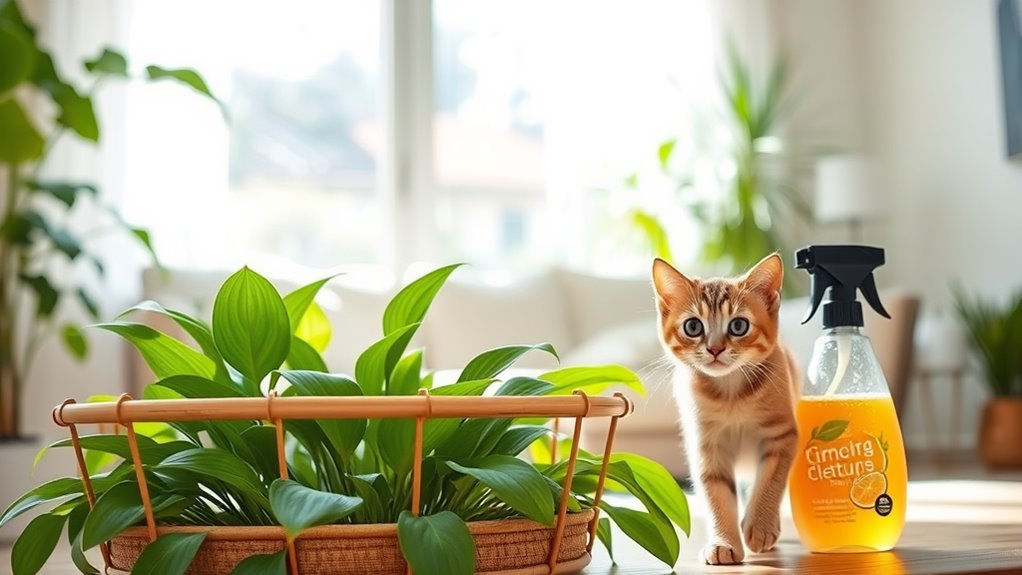
Training your cat to steer clear of indoor plants can be a rewarding challenge. Start by immediately removing your cat from the plant if you catch them digging or biting. Move them to a neutral space to avoid reinforcing their behavior, whether positively or negatively.
Keep your interactions brief and consistent, as this discourages their interest in the plants. To distract your cat, use toys or games that engage their curiosity. Remember, consistency is key; habits form quickly, so be diligent. Additionally, be sure to select cat-safe houseplants that are non-toxic to keep your furry friend safe while maintaining your indoor greenery. It’s also important to understand that narcissistic behaviors can create emotional challenges for pets, as their environment may be affected by human interactions, particularly if they experience emotional neglect. Incorporating recommended reading materials for cat training can provide additional strategies to enhance your efforts.
Lastly, consider using deterrents like citrus scents or vinegar, which cats dislike, to make your plants less appealing. With time and patience, you can successfully train your cat to respect your indoor greenery.
Choosing the Right Plants for Your Home

Choosing the right plants for your home is essential if you want to keep your indoor greenery safe from your curious feline friends.
Opt for cat-resistant choices like cacti, yucca, and dracaena, which deter cats with their textures and shapes. Plants like haworthia and curry plants also help, thanks to their unappealing characteristics. Incorporating sturdy, upright leaves from snake plants can further enhance your collection, as they are not enticing for cats. Additionally, selecting plants that thrive in optimal conditions can ensure they remain healthy and resilient against any curious paws. It’s also important to consider co-parenting plans when determining a safe and stable environment for your pets. Utilizing plants that are known for their eco-friendly materials can not only enhance your home’s aesthetics but also create a safer environment for your cats.
Strong scents can further repel your furry companions; consider lavender, eucalyptus, or citronella. Non-toxic options like money trees and spider plants are safe, but ensure they’re placed out of reach.
Using hanging baskets or high shelves can strategically keep plants safe. Lastly, designating a separate room for your plants can create a cat-free zone, preserving your indoor oasis.
Frequently Asked Questions
Can I Train My Cat to Leave Plants Alone?
Yes, you can train your cat to leave plants alone.
Start by using a firm “no” when they approach and redirect them to cat-friendly alternatives like catnip.
Keep their environment engaging with toys and climbing structures to reduce boredom.
Reward them with treats and praise when they ignore the plants.
Consistency is key, so stay patient and persistent in your training efforts to help your cat learn the desired behavior.
Are There Any Plants That Naturally Repel Cats?
Oh sure, because why wouldn’t you want your feline friend to turn your lush garden into a scratching post?
Thankfully, some plants naturally repel cats! Lavender, lemongrass, and rosemary are your allies in this battle.
Cats can’t stand their scents, so planting these around your home might just save your greenery.
If that doesn’t work, you can always try sprinkling a little cayenne pepper – just don’t sneeze!
How Can I Tell if a Plant Is Safe for Cats?
To tell if a plant is safe for your cat, always check its scientific name against reliable sources like the ASPCA’s list of non-toxic plants.
Avoid common names, as they can be misleading.
Look out for toxic plants like peace lilies and sago palms, and monitor your cat’s interaction with any plant.
If you’re unsure, consult your vet for guidance on pet-safe options and potential risks.
What Are the Signs My Cat Is Attracted to Plants?
If you notice your cat sniffing, exploring, or nibbling on plants, that’s a clear sign they’re attracted.
Watch for them digging in the soil, rubbing against the leaves, or playing with dangling fronds. These behaviors stem from their natural curiosity and playfulness.
Additionally, if they seem particularly drawn to certain textures or scents, it’s likely those plants pique their interest.
Keep an eye out for these signs to understand their fascination!
Can I Use Homemade Sprays Instead of Commercial Ones?
Did you know that over 50% of pet owners prefer homemade solutions for their pets?
You can absolutely use homemade sprays instead of commercial ones. They’re often cheaper, made from natural ingredients, and you can customize them to suit your needs.
Just remember to dilute essential oils to protect your cat and test any spray on a small part of your plants first.
Consistent application is key for effectiveness, so keep that in mind!
Conclusion
Keeping your cats away from indoor plants doesn’t have to feel like a battle. With the right strategies, like using repellents and creating barriers, you can cultivate a peaceful coexistence. Think of your home as a delicate garden where both your plants and pets thrive in harmony. By offering cat-friendly alternatives and training your feline friends, you’ll create a vibrant space that’s enjoyable for everyone. Embrace these tips, and watch your plants flourish while your cats stay curious yet content!

